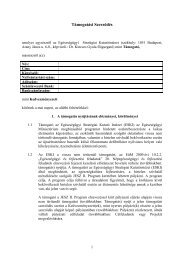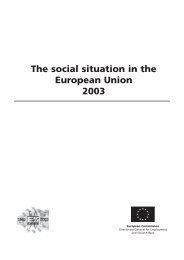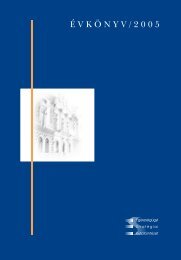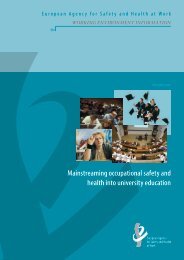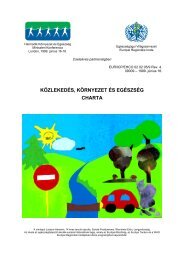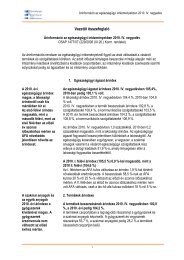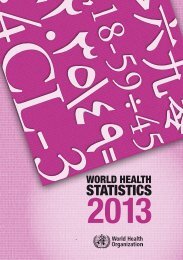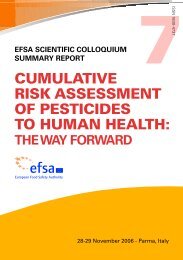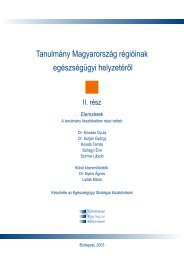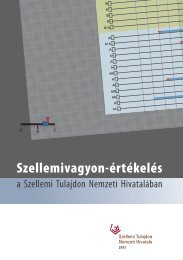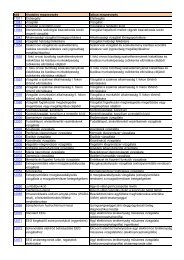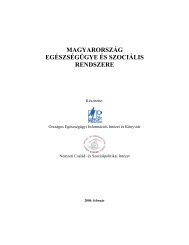WHO Technical Report Series, No. 981 - World Health Organization
WHO Technical Report Series, No. 981 - World Health Organization
WHO Technical Report Series, No. 981 - World Health Organization
Create successful ePaper yourself
Turn your PDF publications into a flip-book with our unique Google optimized e-Paper software.
<strong>WHO</strong> Expert Committee on Specifications for Pharmaceutical Preparations Forty-seventh report<br />
Table continued<br />
Description of change<br />
Conditions to<br />
be fulfilled<br />
Documentation<br />
required<br />
<strong>Report</strong>ing<br />
type<br />
31a Change in the<br />
1–9 1–4, 6–7 AN<br />
31b<br />
manufacturing process of<br />
the FPP<br />
1–3, 5–9 1–7 Vmin<br />
Conditions to be fulfilled<br />
1. The change does not require supporting in vivo data.<br />
2. <strong>No</strong> change in qualitative and quantitative impurity profile or in physicochemical<br />
properties; dissolution profiles are similar to those of the biobatch.<br />
3. The manufacturing processes for the currently accepted and proposed products<br />
use the same principles (e.g. a change from wet to dry granulation, from direct<br />
compression to wet or dry granulation or vice versa would be considered a change<br />
in manufacturing principle), the same processing intermediates and there are no<br />
changes to any manufacturing solvent used in the process.<br />
4. The same classes of equipment, operating procedures, in-process controls (with no<br />
widening or deleting of limits) are used for the currently accepted and proposed<br />
products; no change in critical process parameters.<br />
5. <strong>No</strong> change in the specifications of the intermediates or the FPP.<br />
6. The change is not necessitated by failure to meet specifications resulting from<br />
unexpected events arising during manufacture, or because of stability concerns.<br />
7. The change does not involve packaging or labelling where the primary packaging<br />
provides a metering and/or delivery function.<br />
8. The change does not concern a gastro-resistant, modified or prolonged-release FPP.<br />
9. The change does not affect the sterilization parameters of a sterile FPP.<br />
<strong>WHO</strong> <strong>Technical</strong> <strong>Report</strong> <strong>Series</strong> <strong>No</strong>. <strong>981</strong>, 2013<br />
138<br />
Documentation required<br />
1. Supporting clinical or comparative bioavailability data or justification for not<br />
submitting a new bioequivalence study according to the current <strong>WHO</strong> guidelines<br />
on bioequivalence.<br />
2. (P.2) Discussion on the development of the manufacturing process; where<br />
applicable:<br />
• comparative in vitro testing, e.g. multipoint dissolution profiles in the routine<br />
release medium for solid dosage units (one production batch and comparative<br />
data on one batch from the previous process and the biobatch results; data on<br />
the next two production batches should be available on request or reported if<br />
outside specification);<br />
• comparative in vitro membrane diffusion (membrane release testing) for<br />
non-sterile semisolid dosage forms containing the API in the dissolved or nondissolved<br />
form (one production batch and comparative data on one batch<br />
from the previous process and the biobatch results; data on the next two<br />
production batches should be submitted or be available on request);<br />
continues



